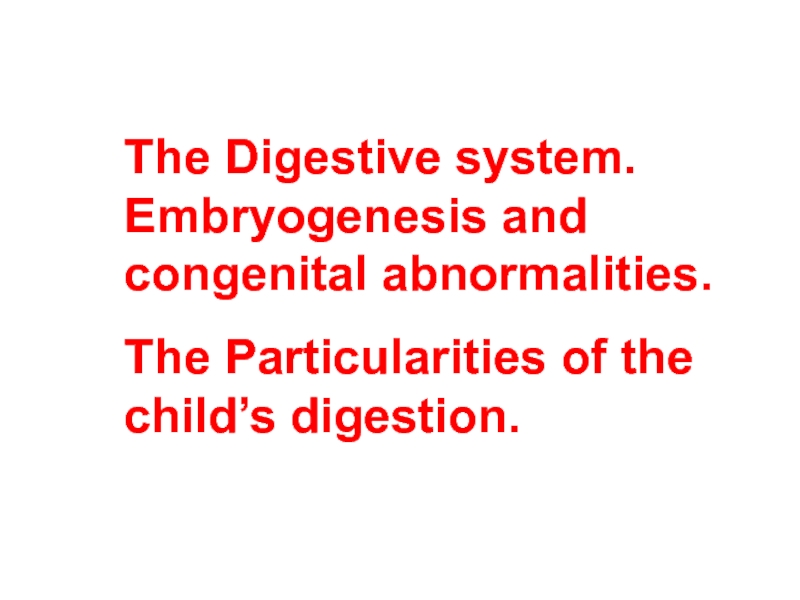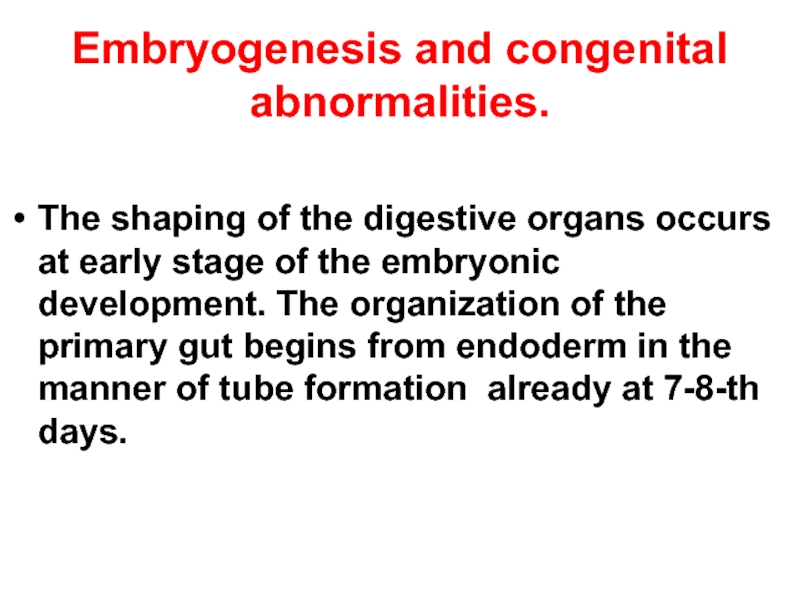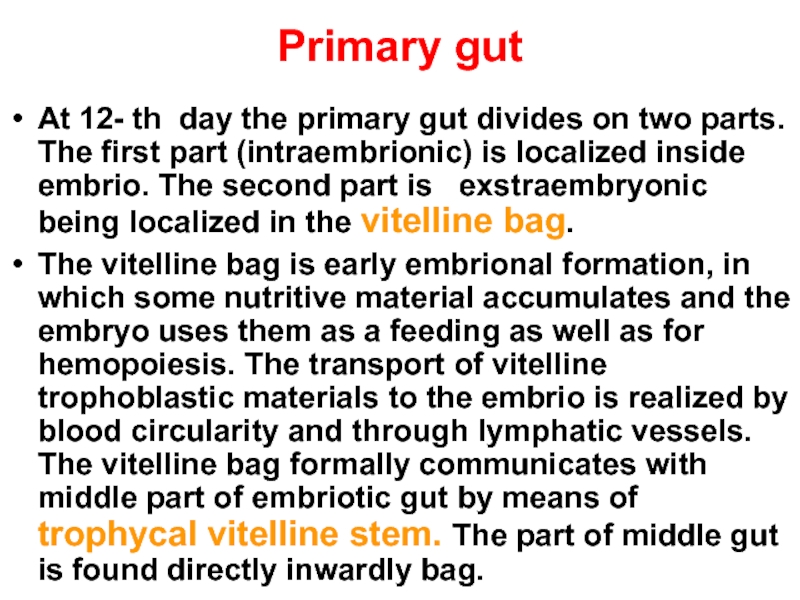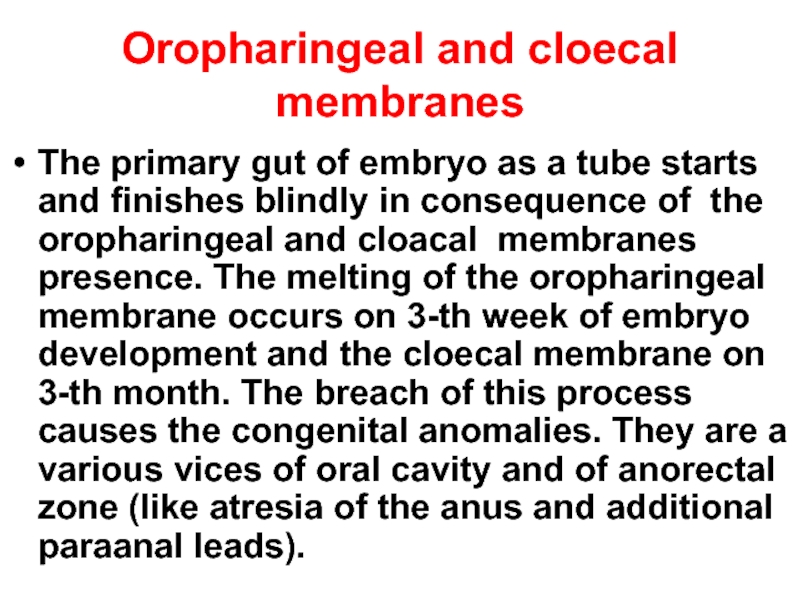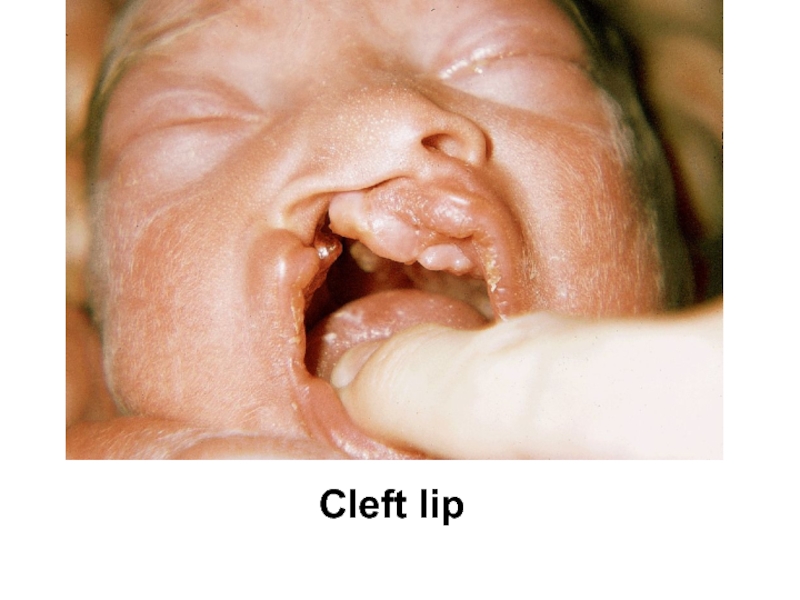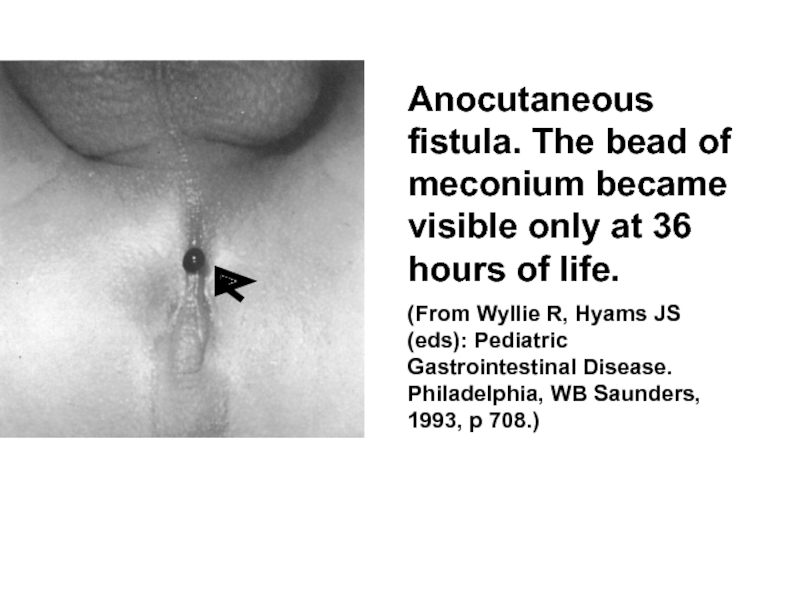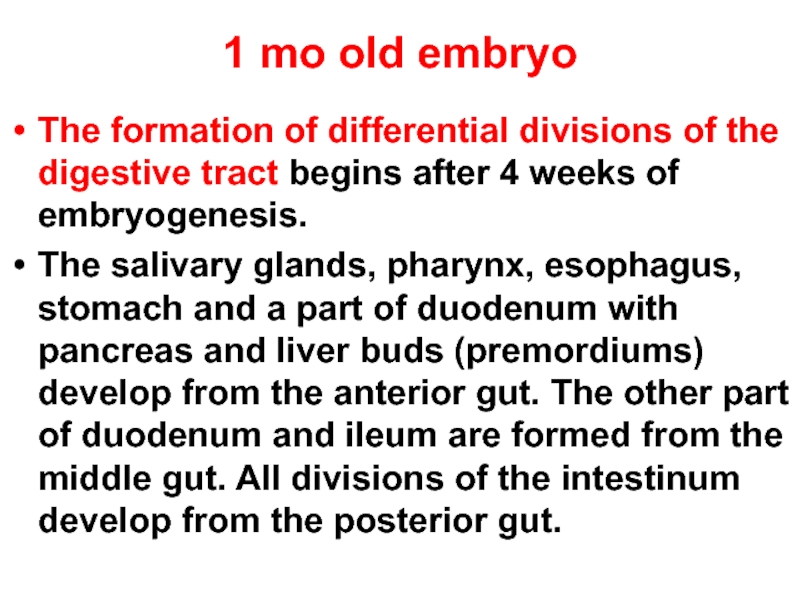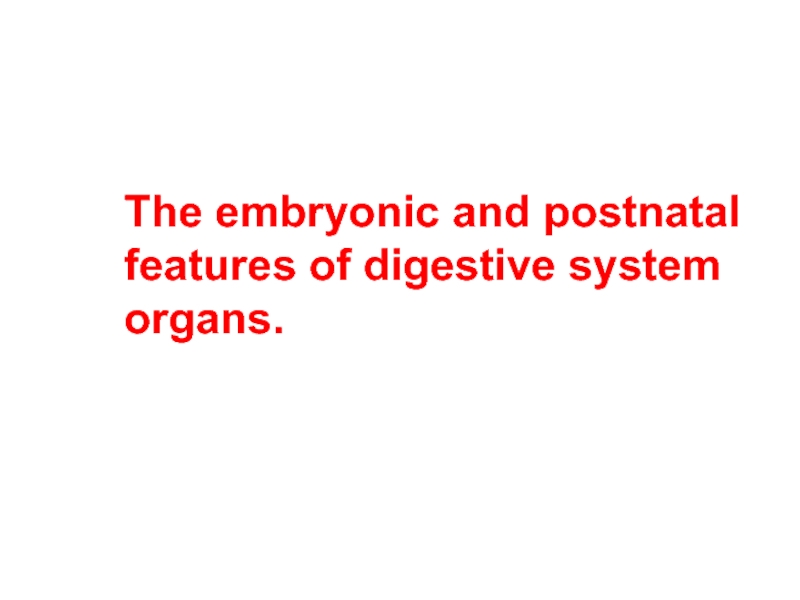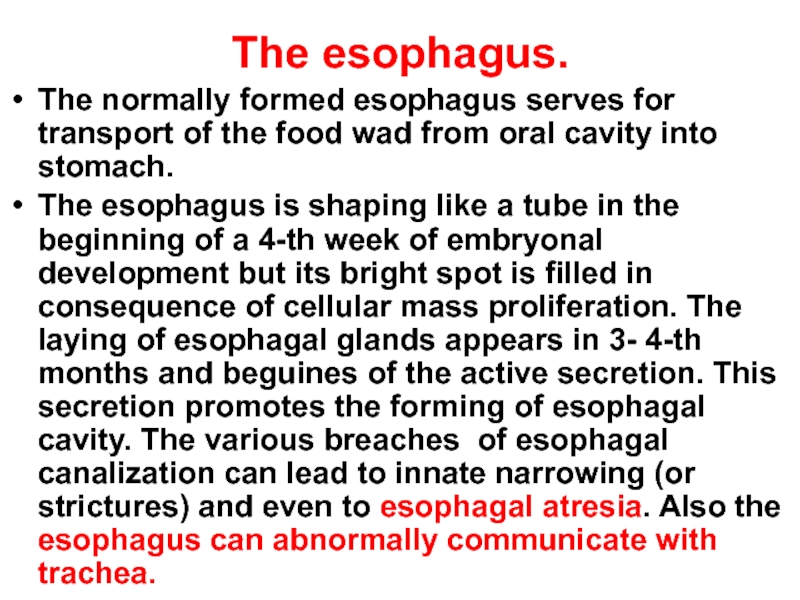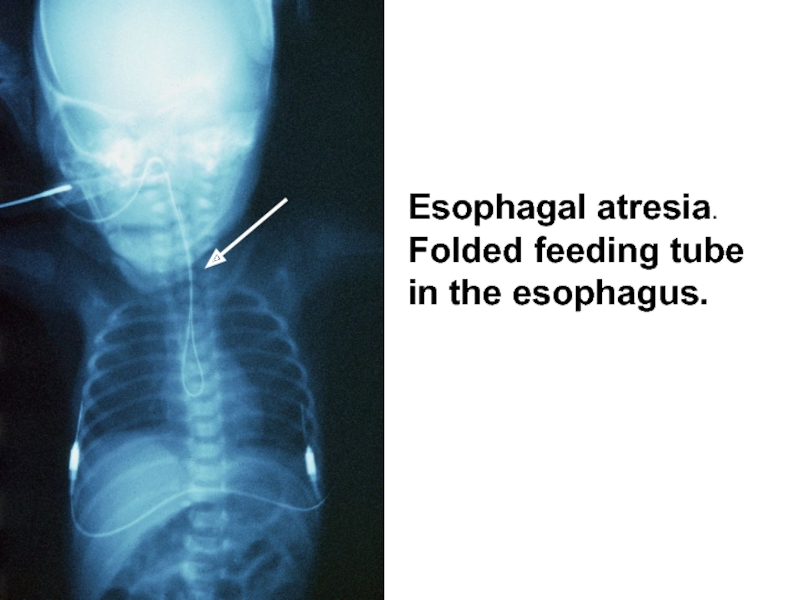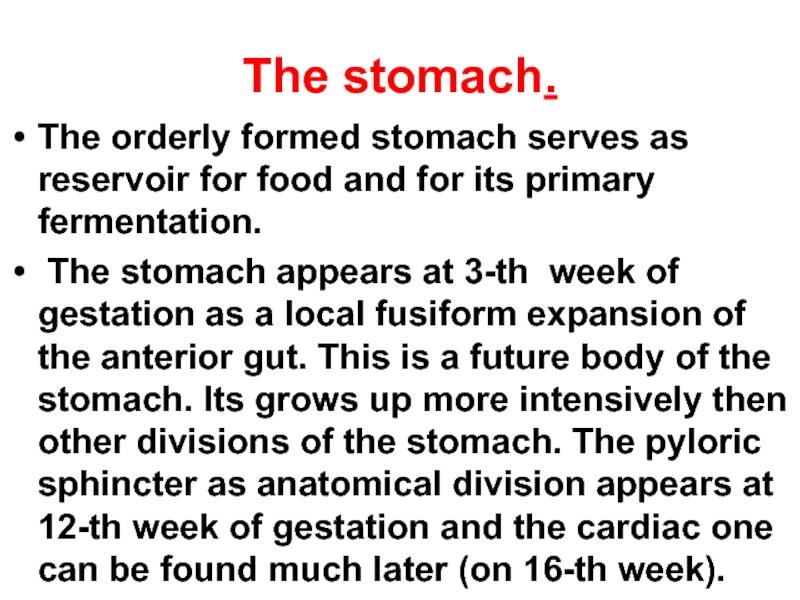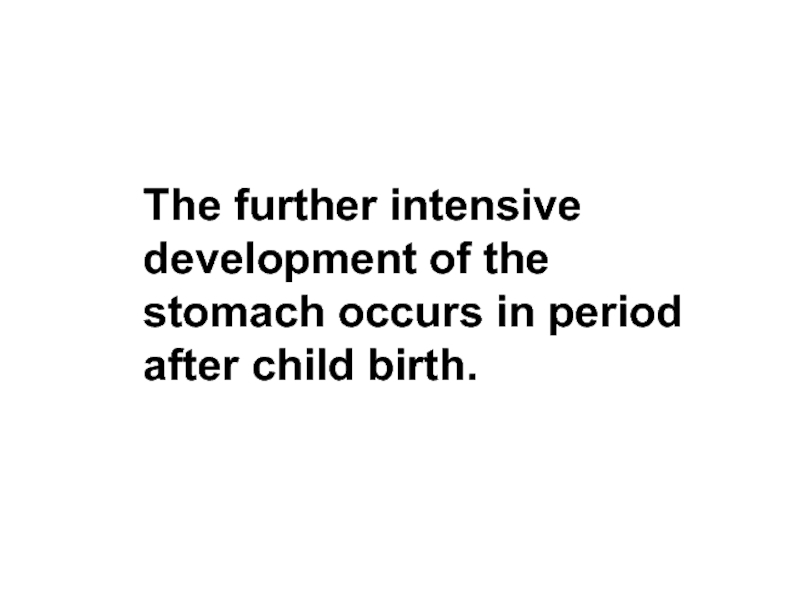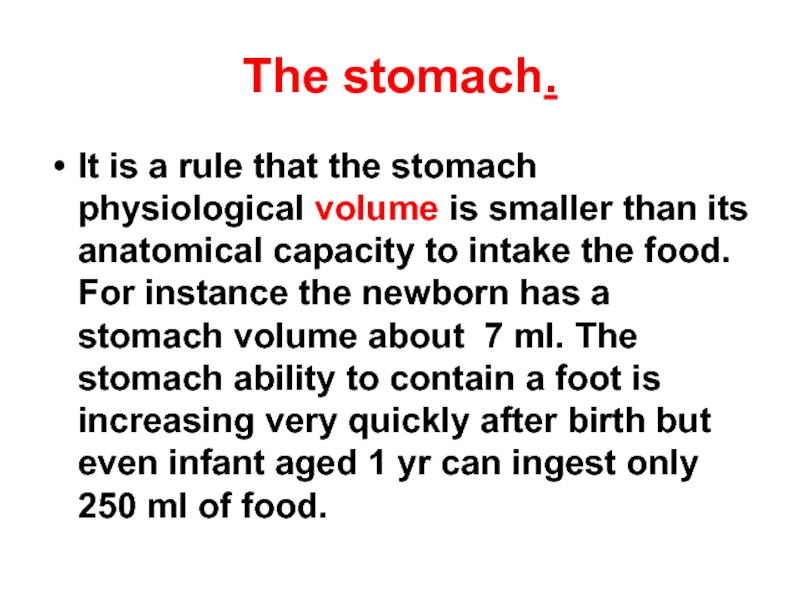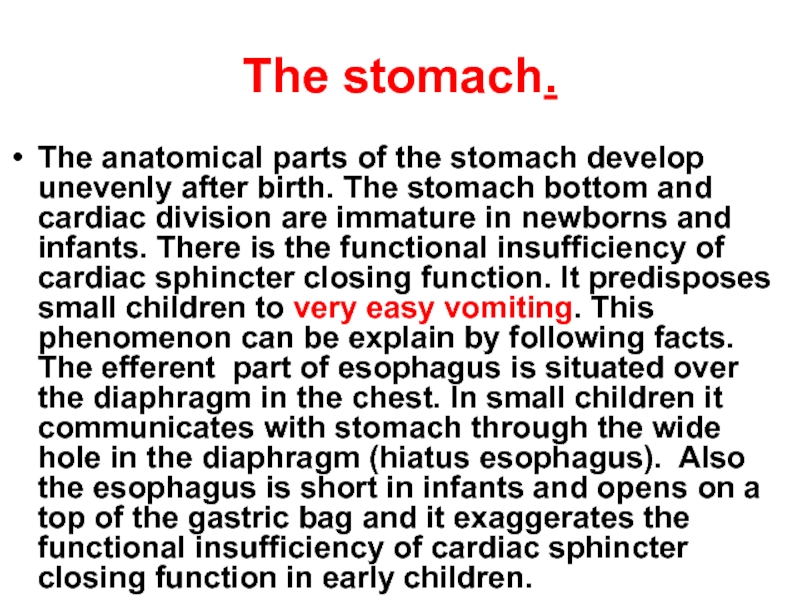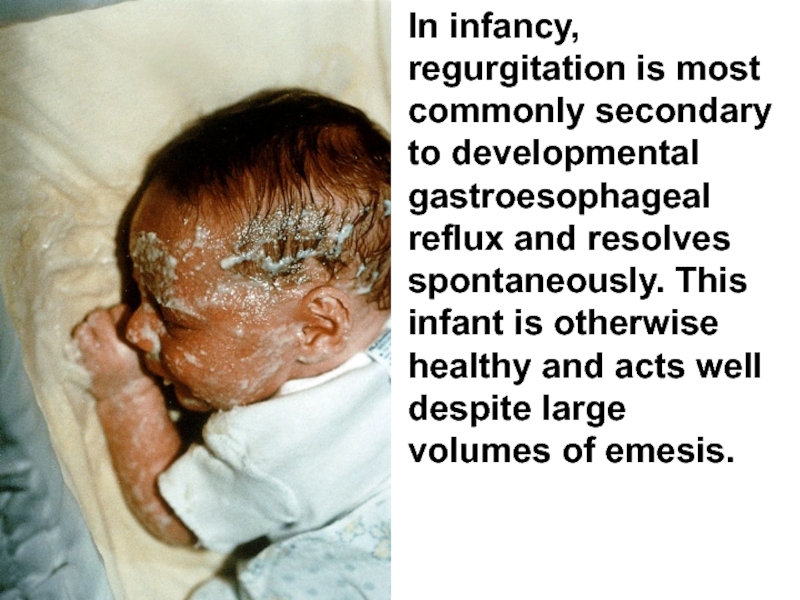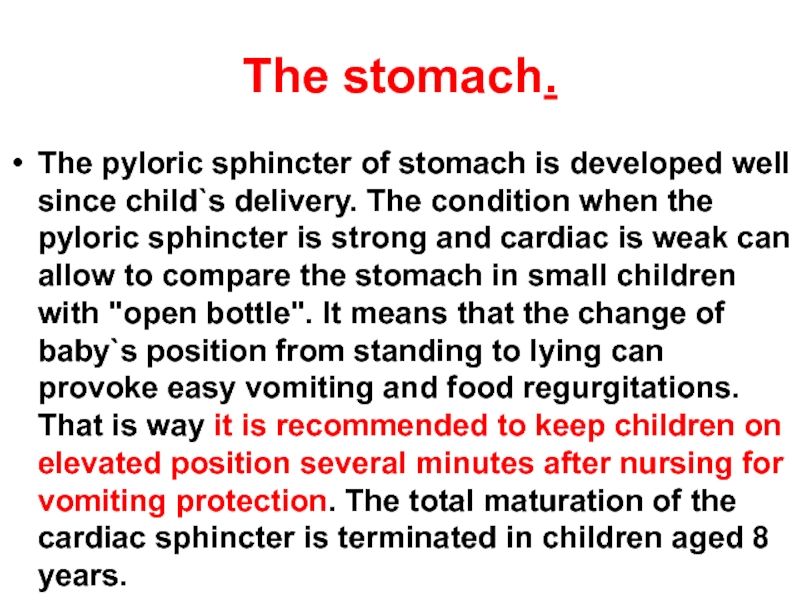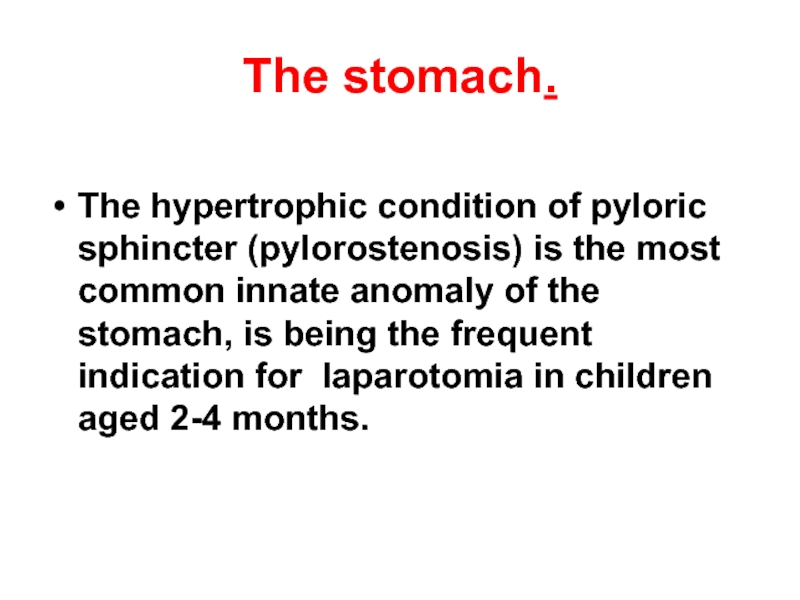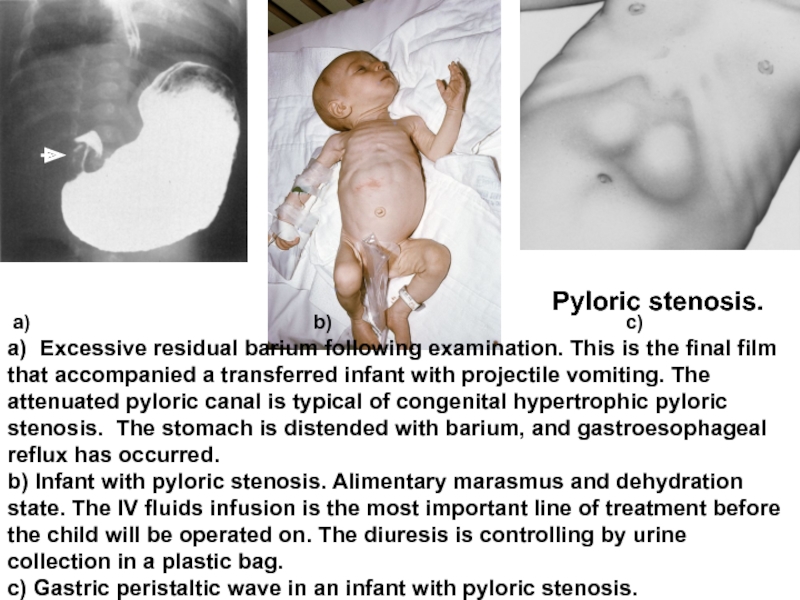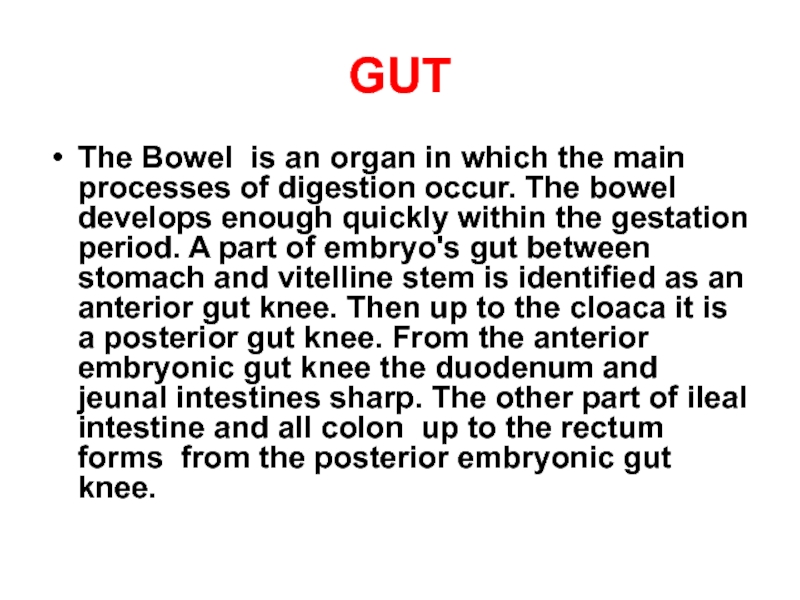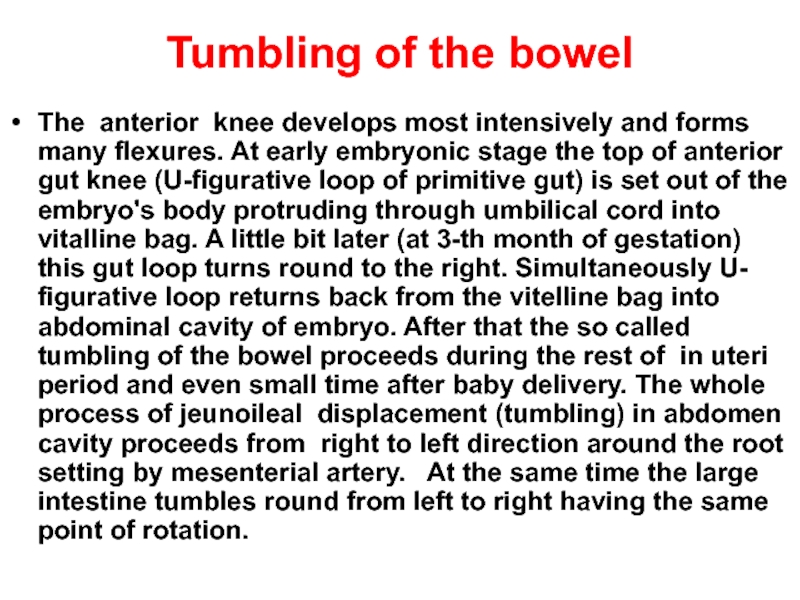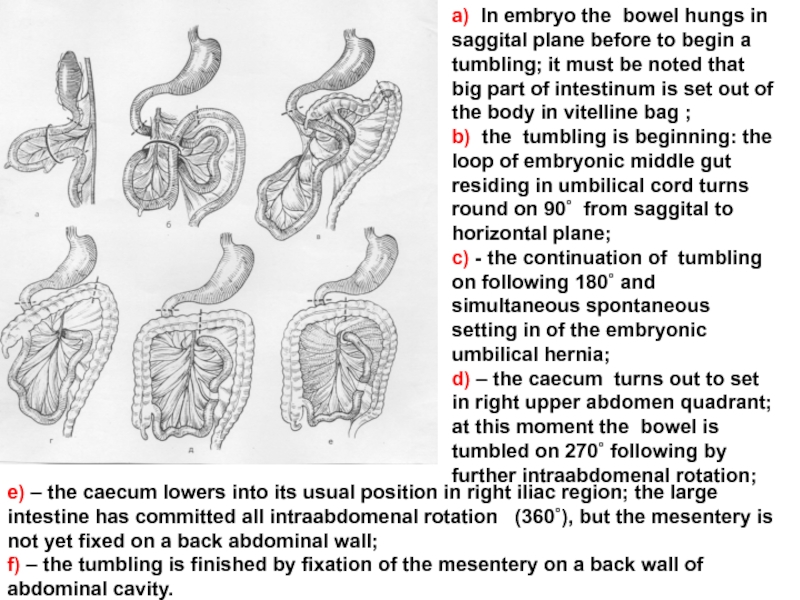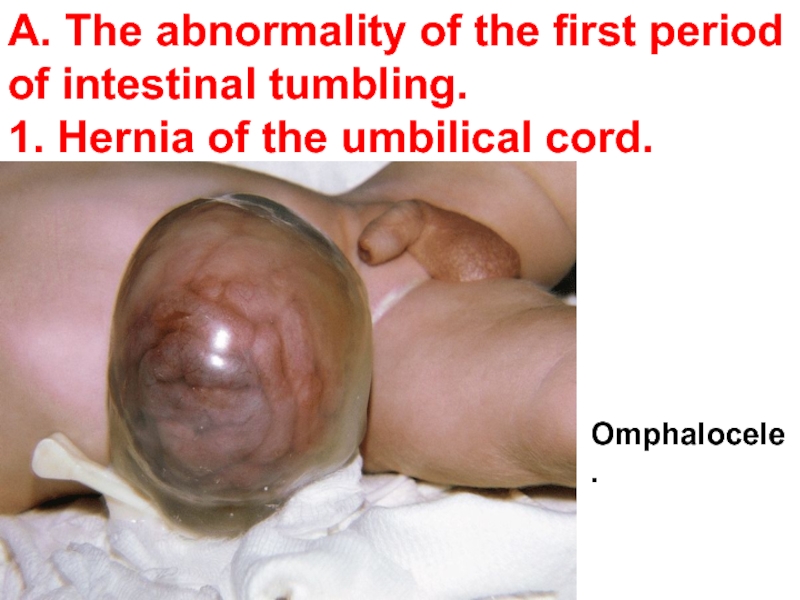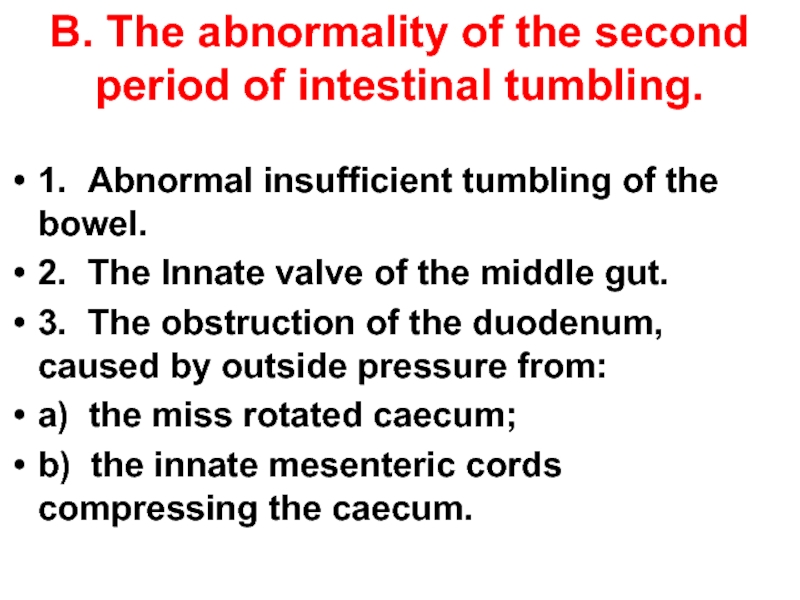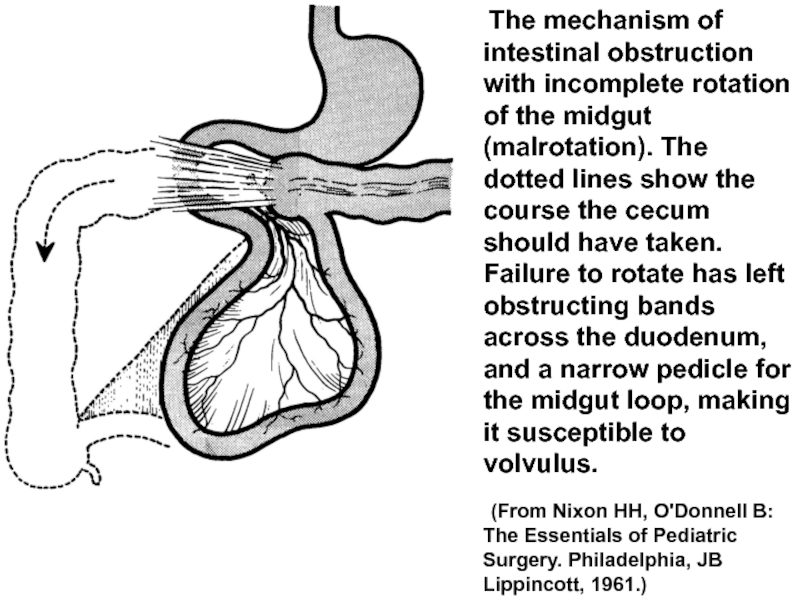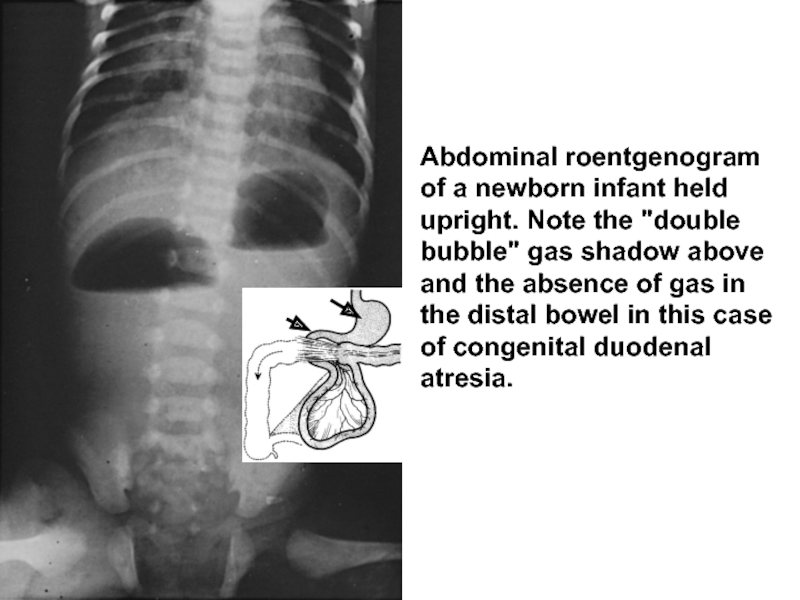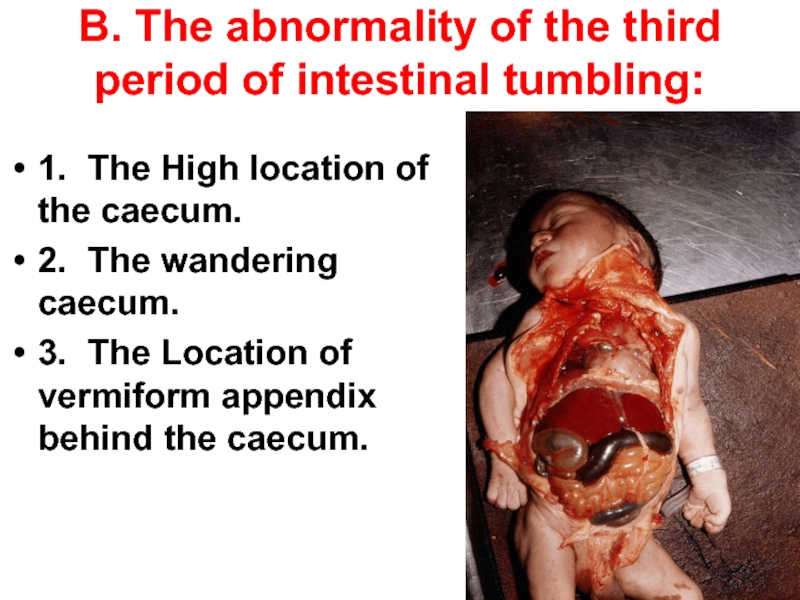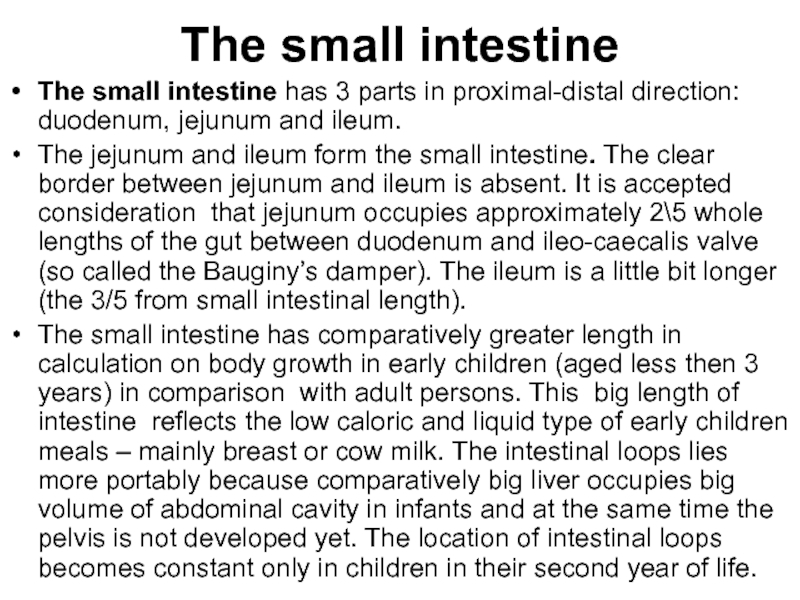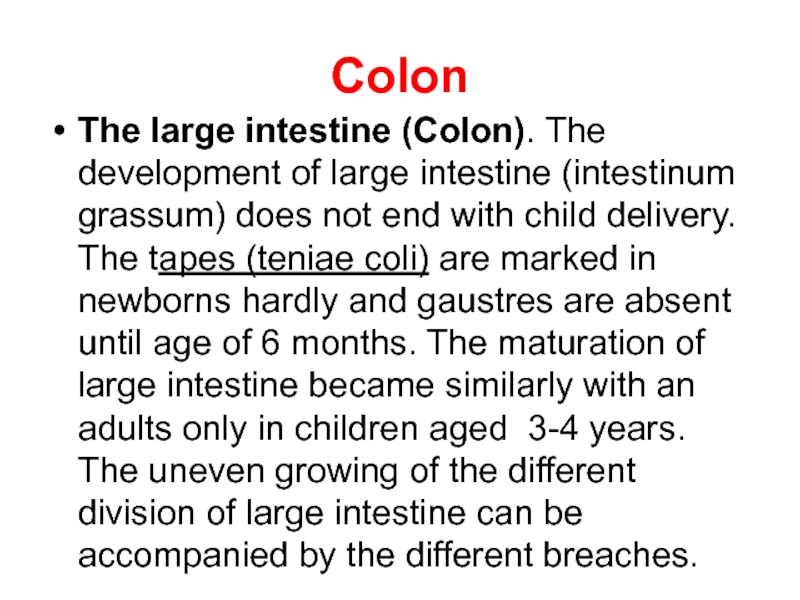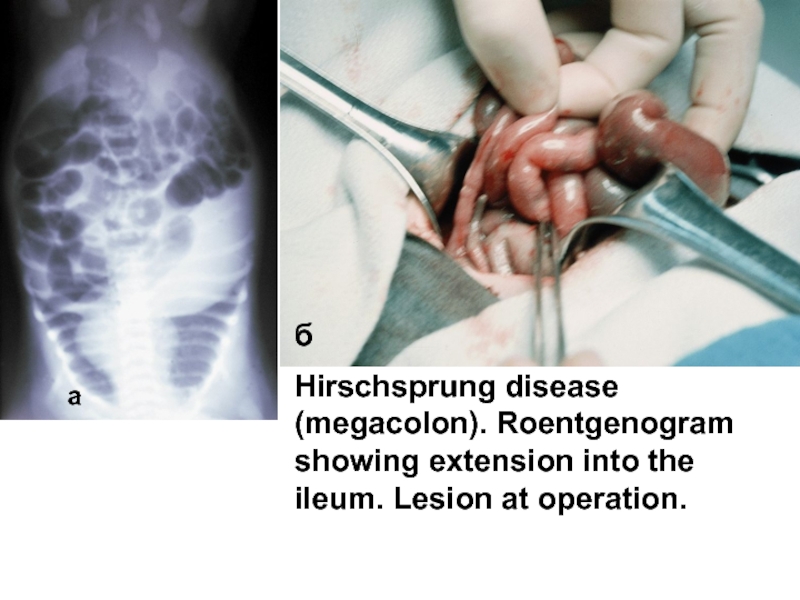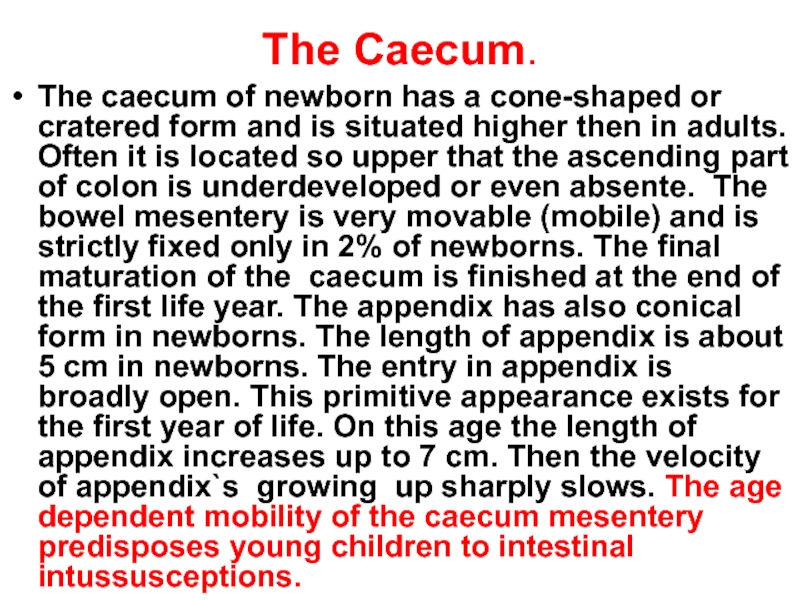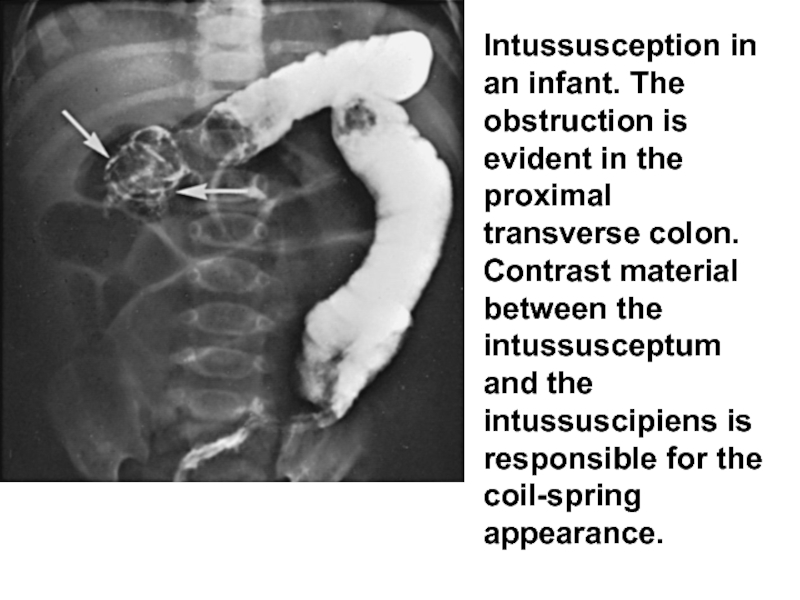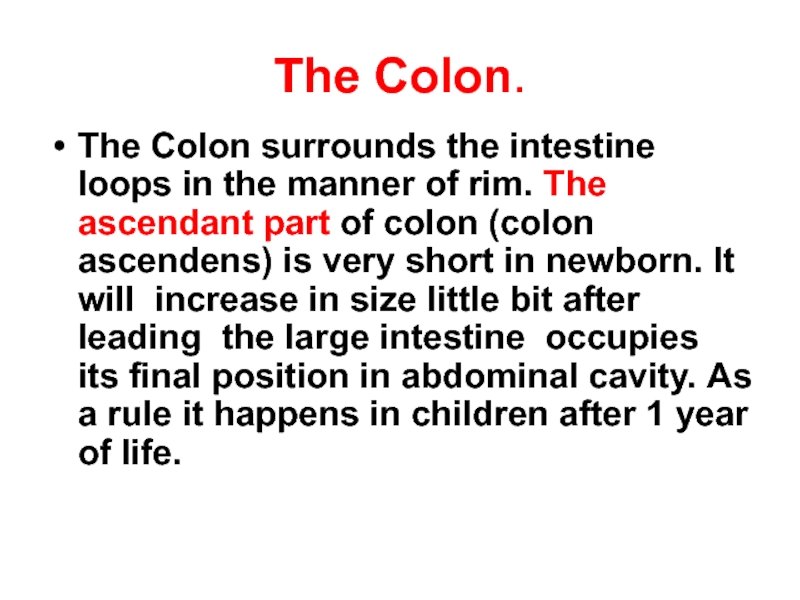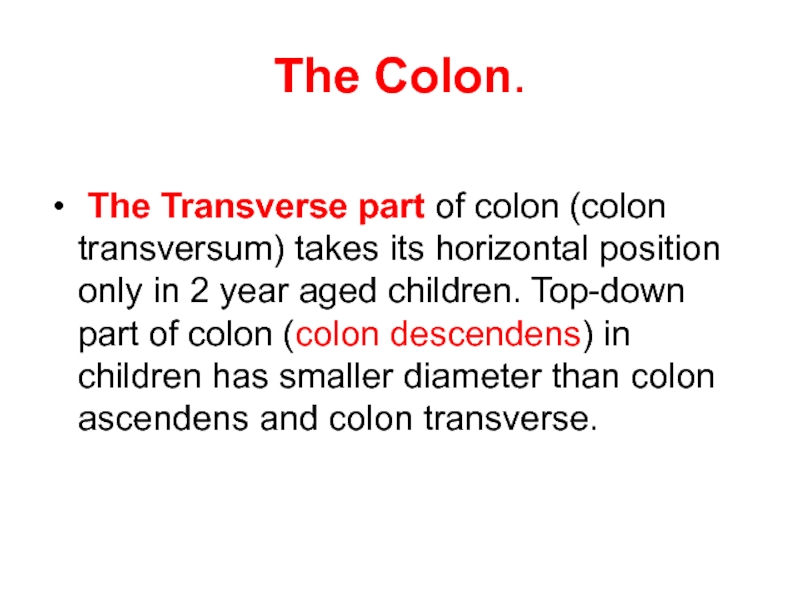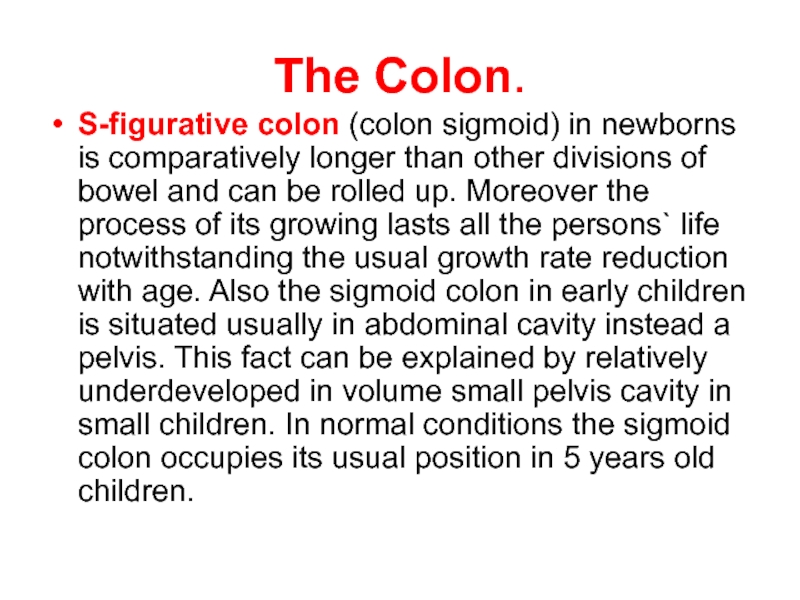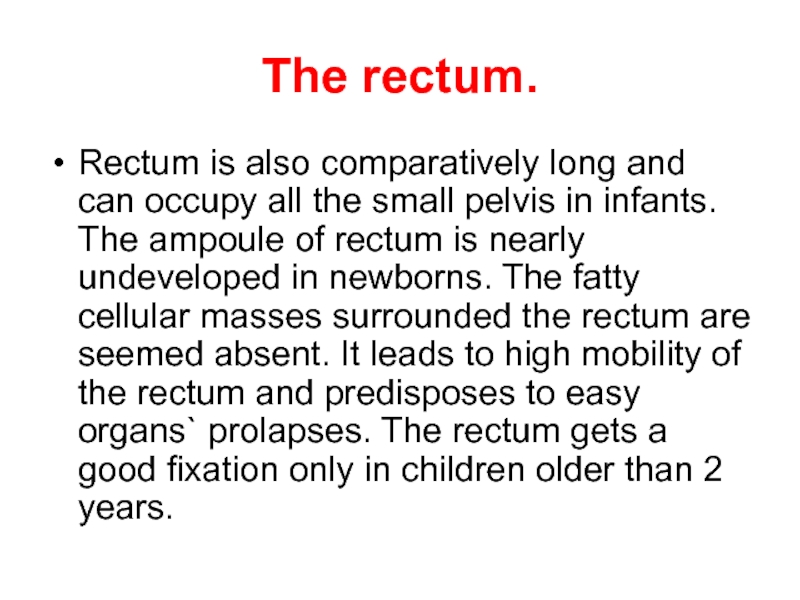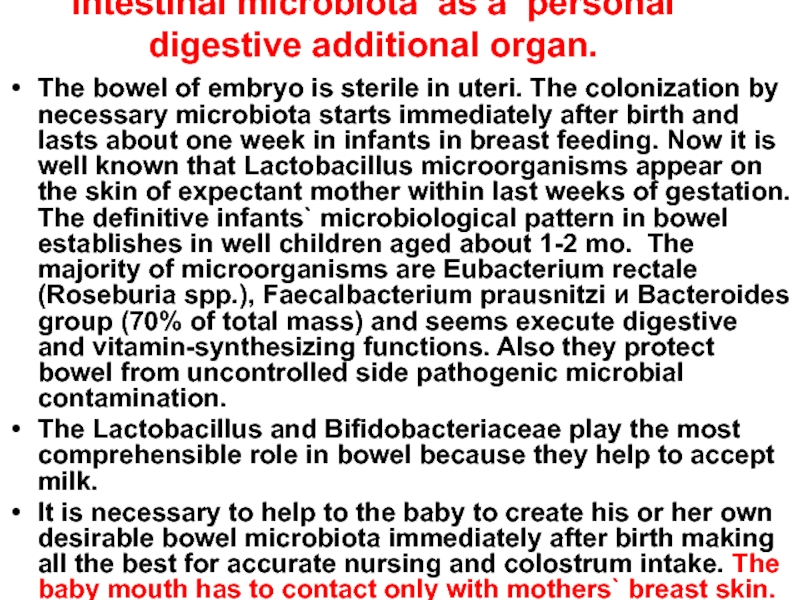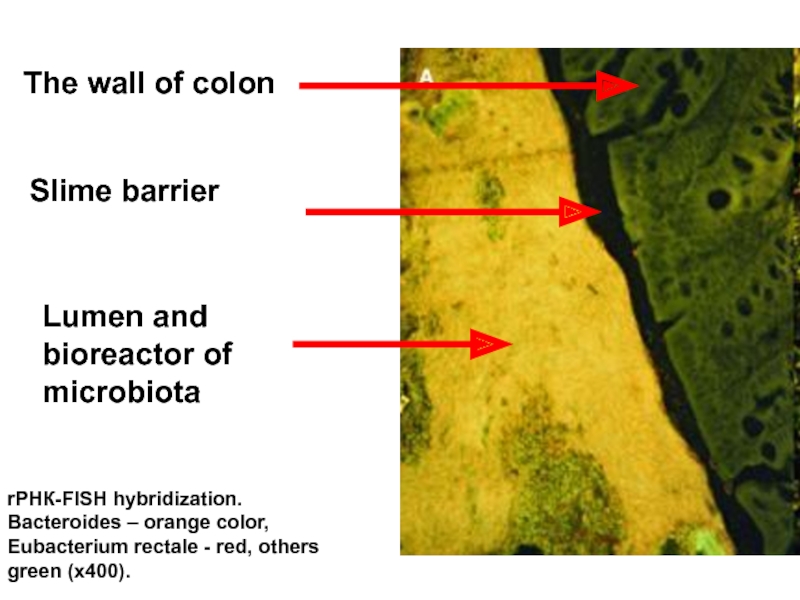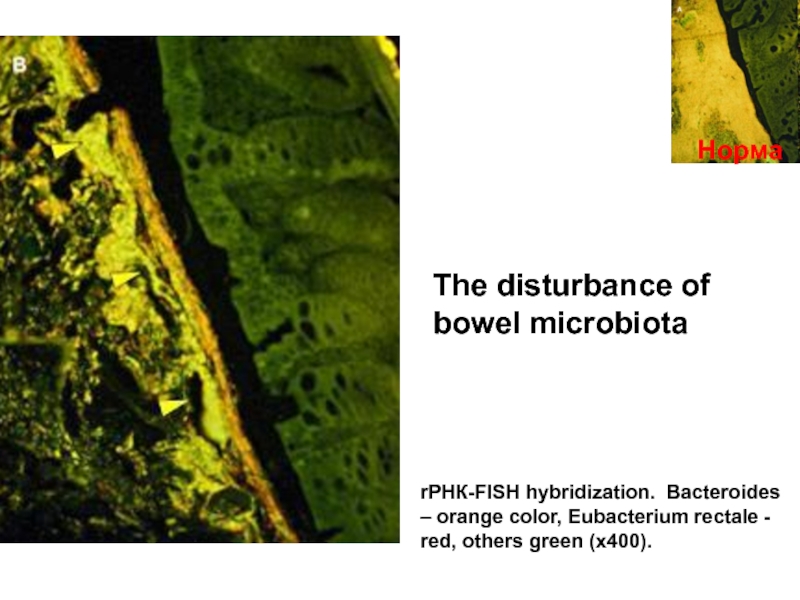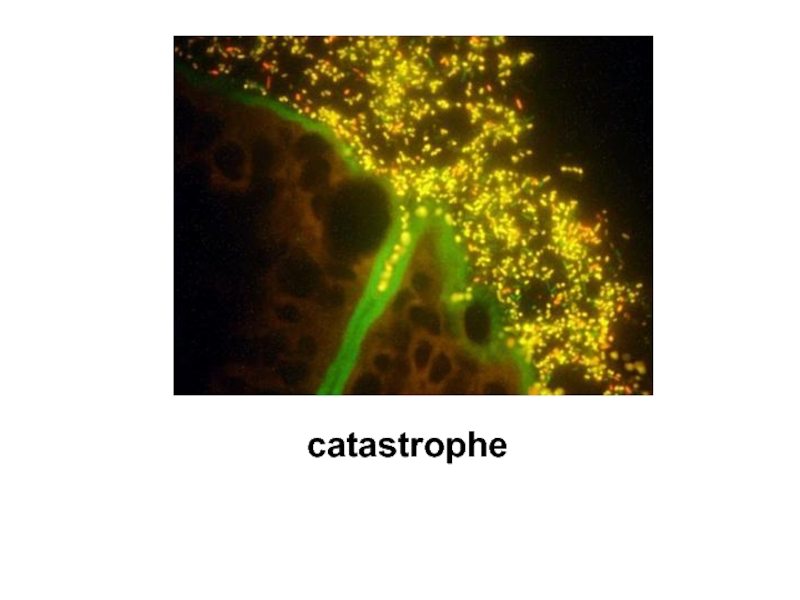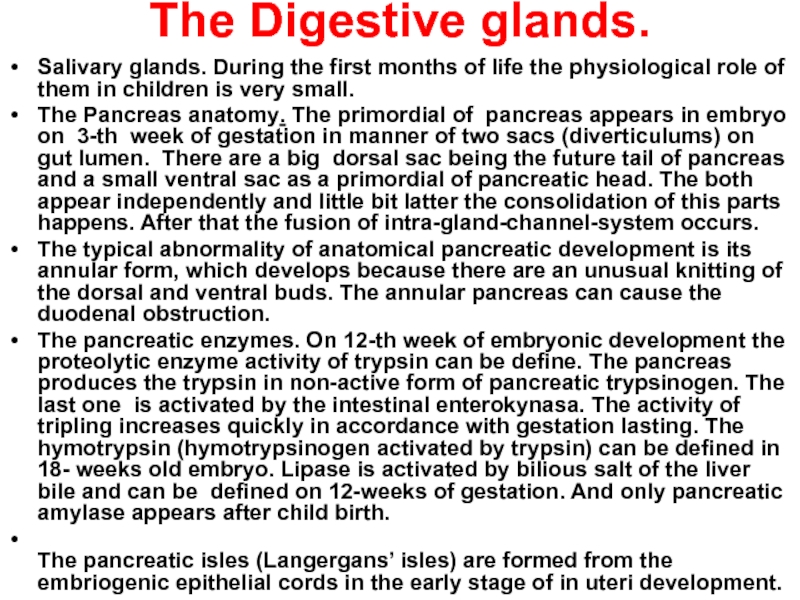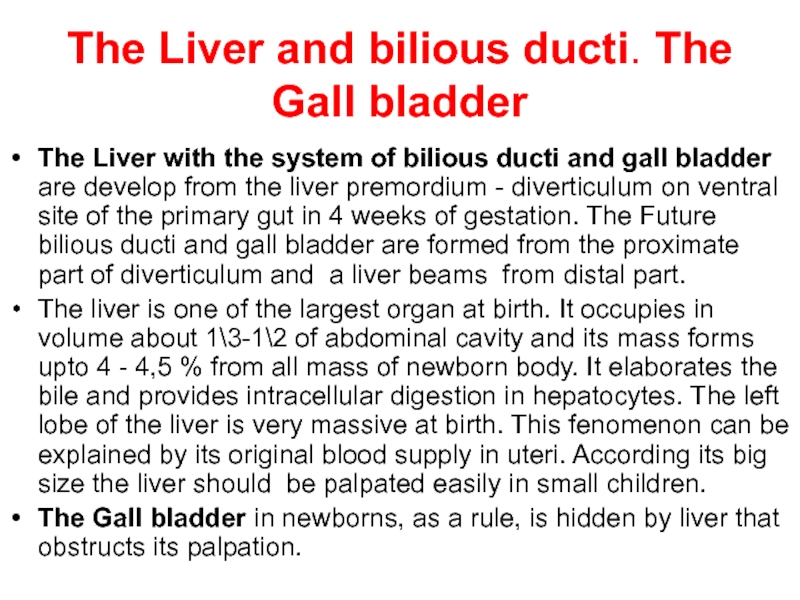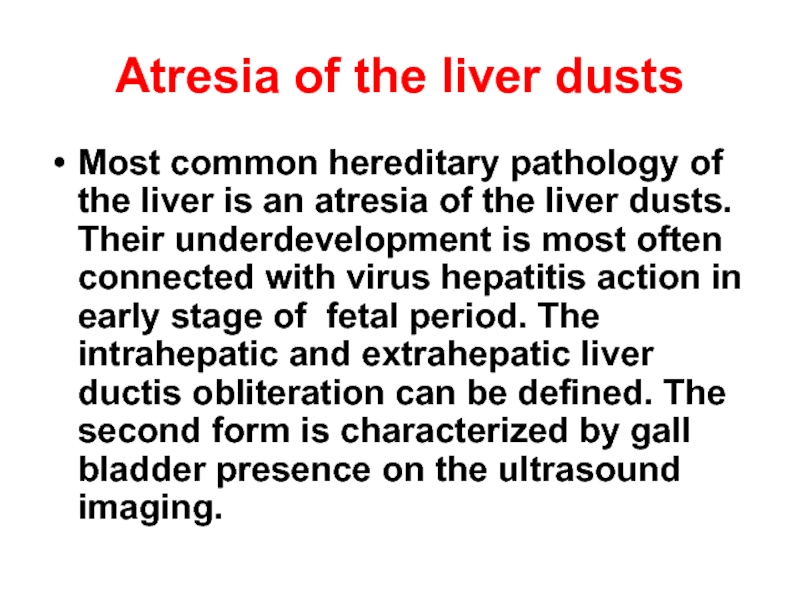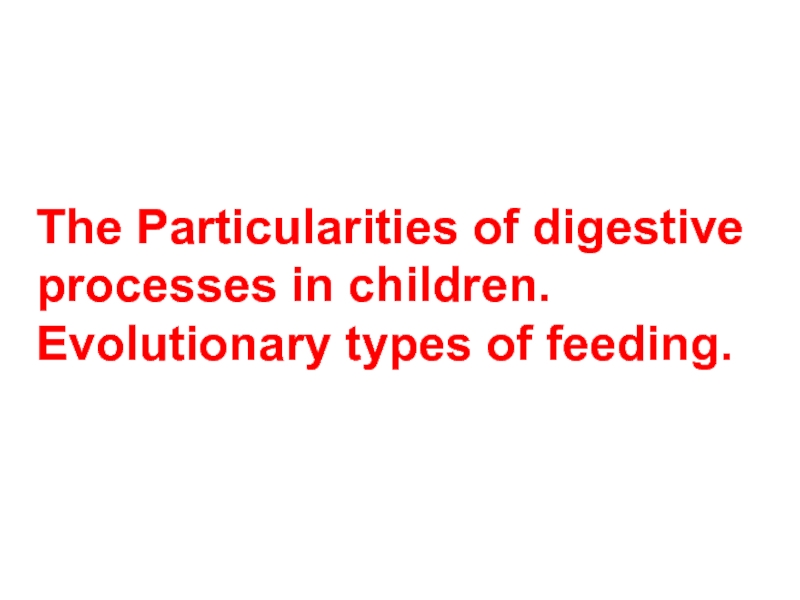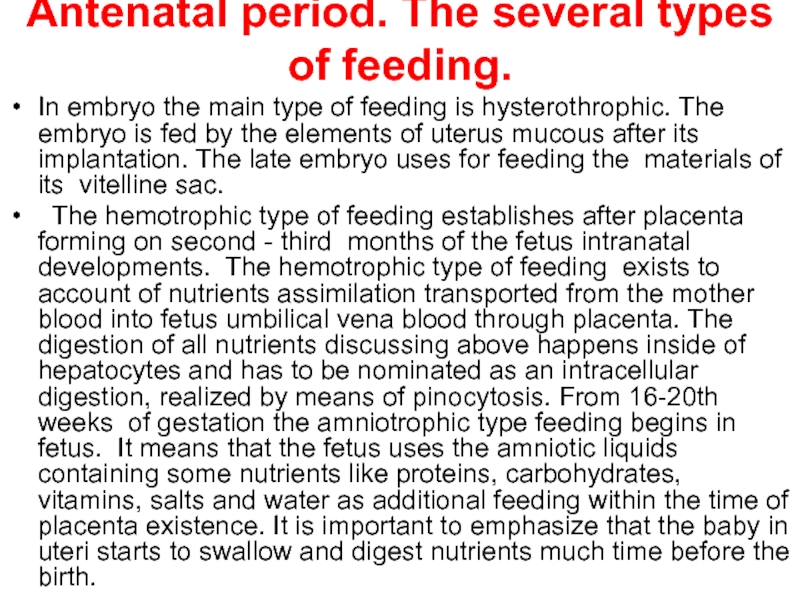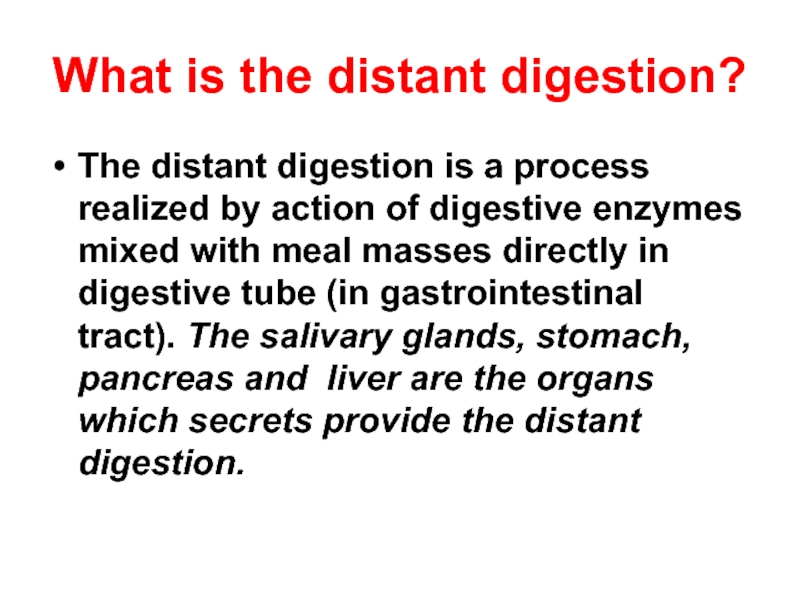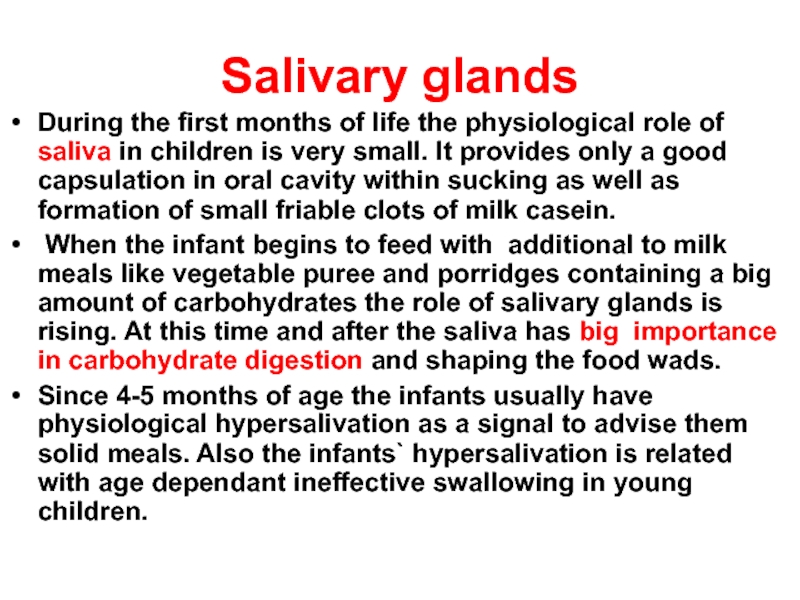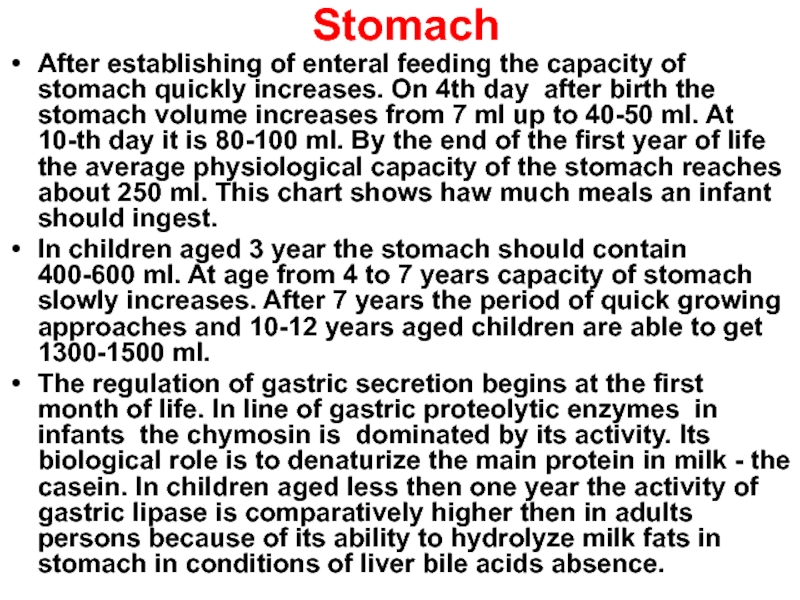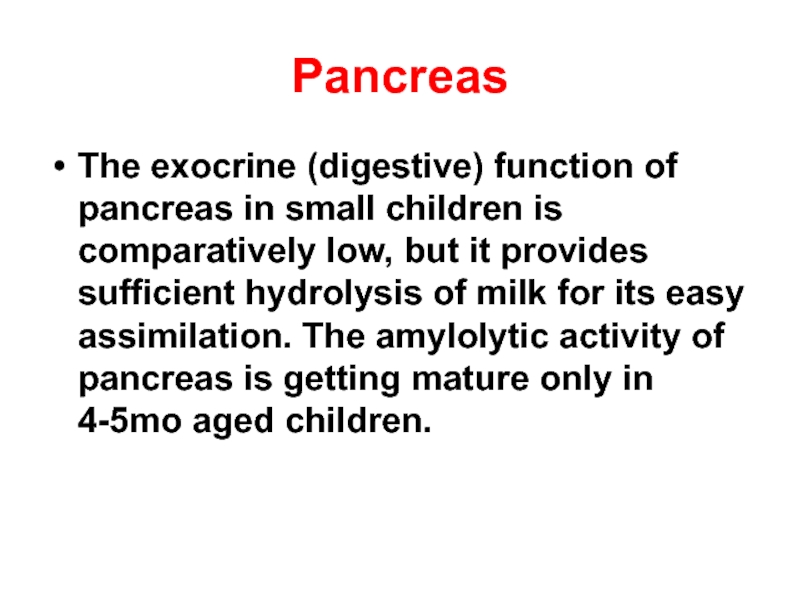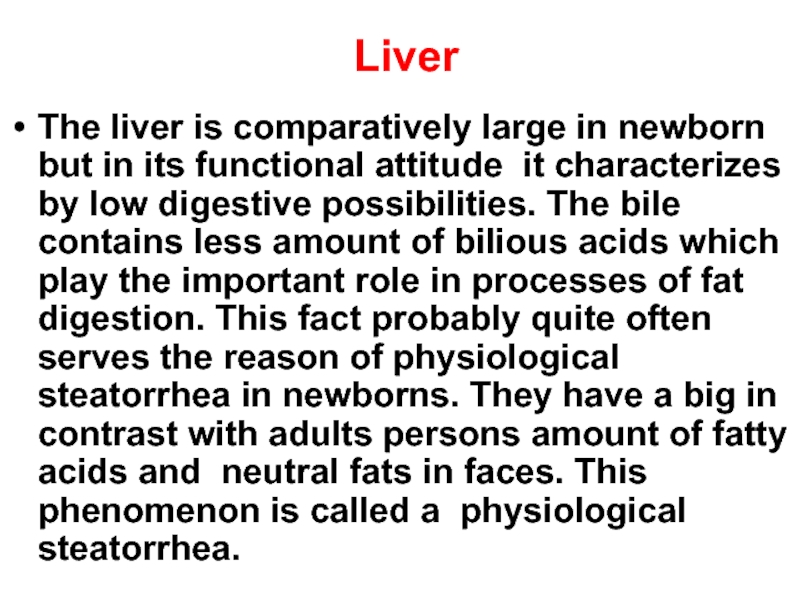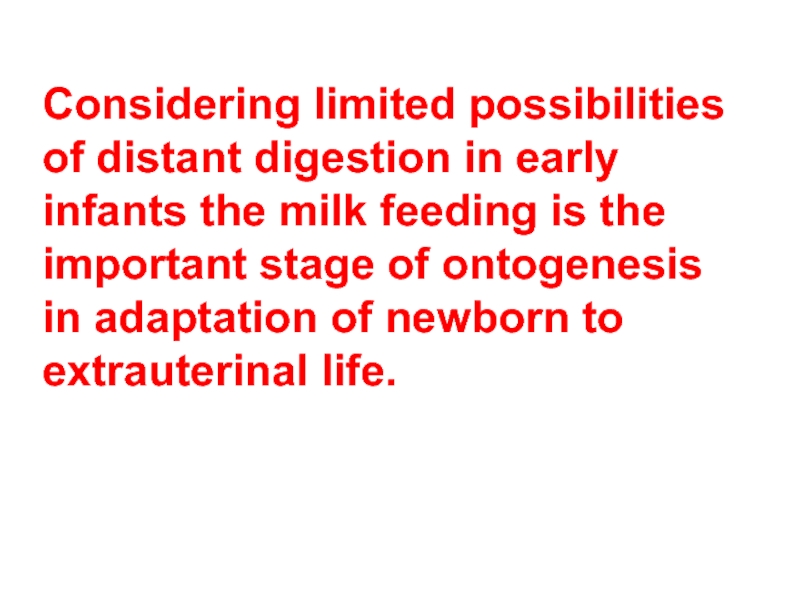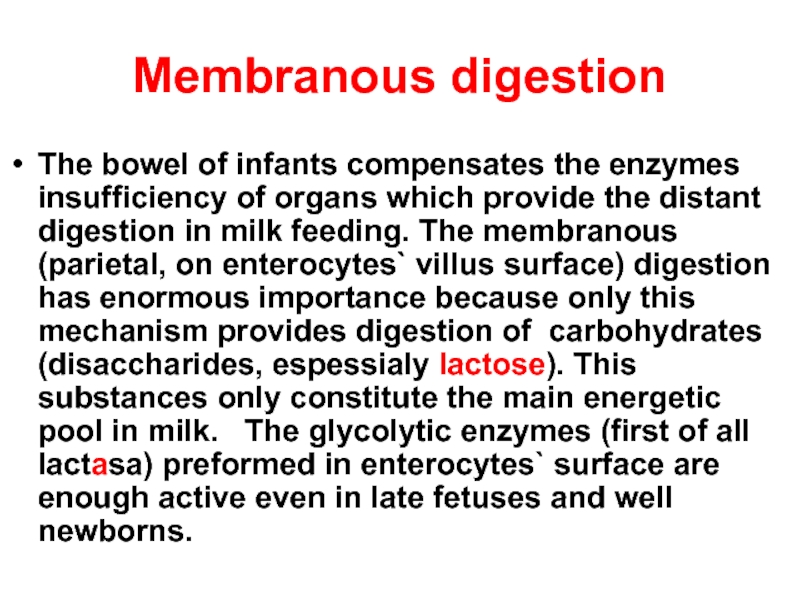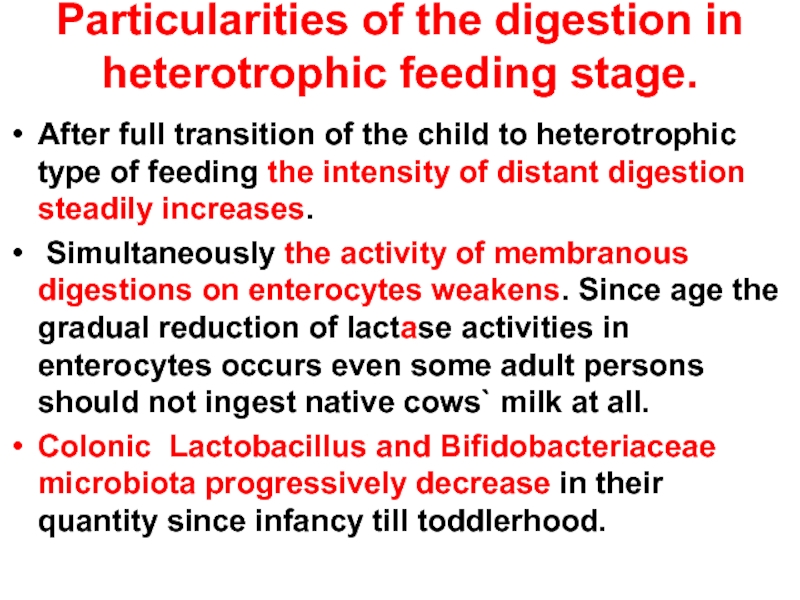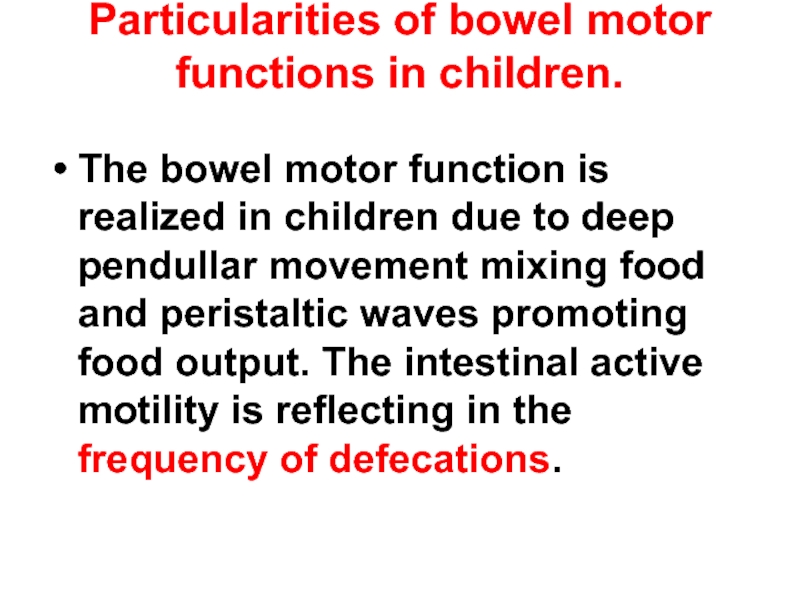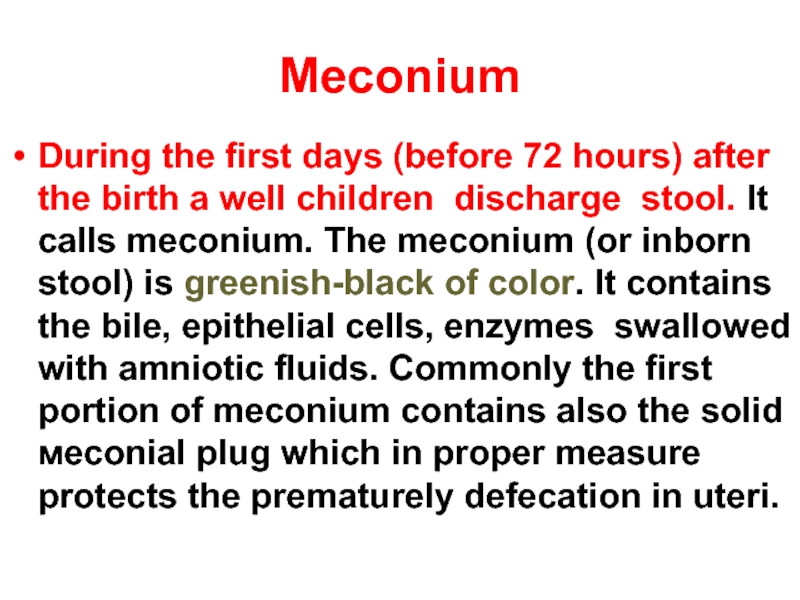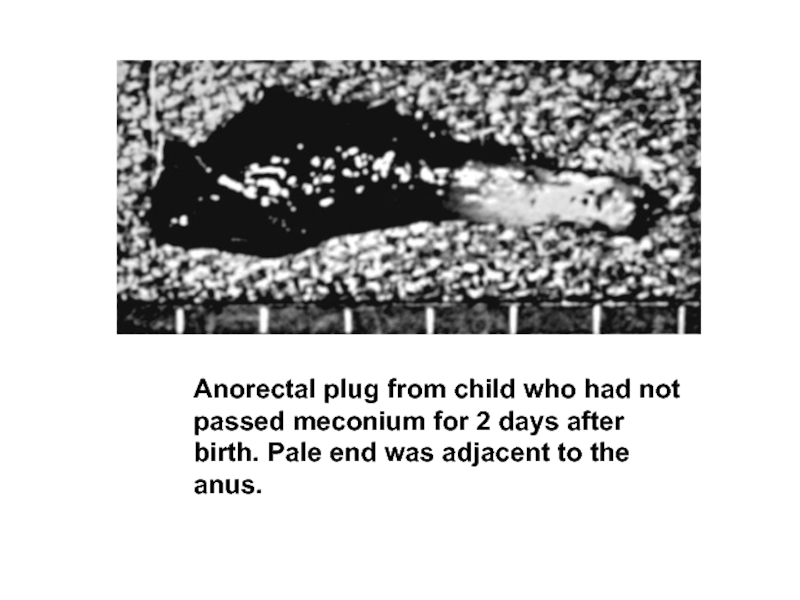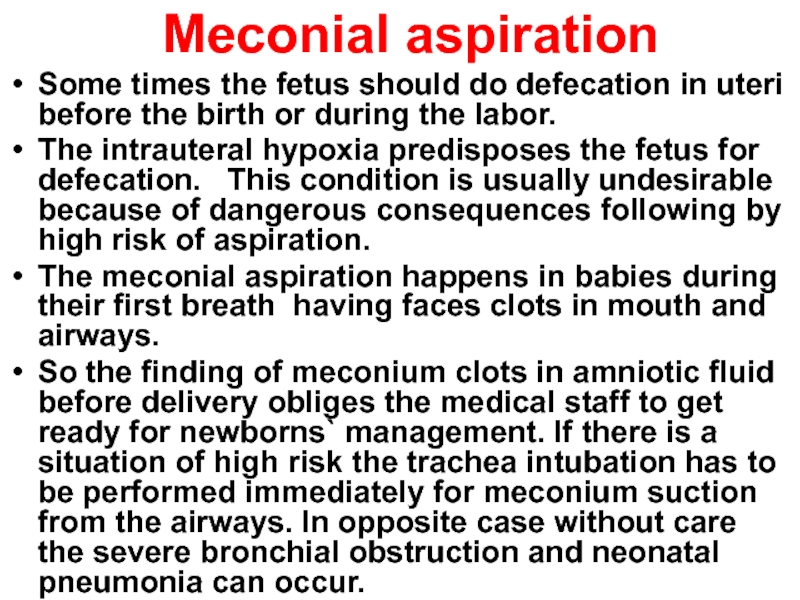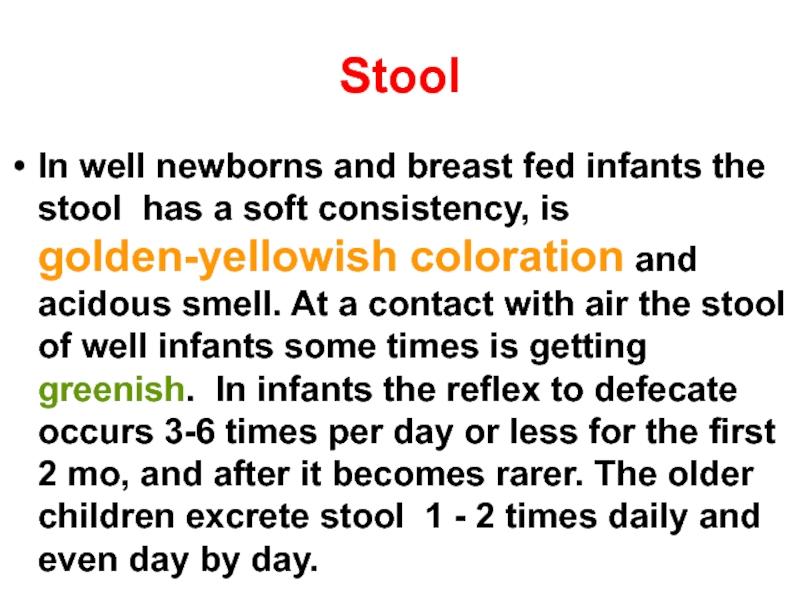- Главная
- Разное
- Дизайн
- Бизнес и предпринимательство
- Аналитика
- Образование
- Развлечения
- Красота и здоровье
- Финансы
- Государство
- Путешествия
- Спорт
- Недвижимость
- Армия
- Графика
- Культурология
- Еда и кулинария
- Лингвистика
- Английский язык
- Астрономия
- Алгебра
- Биология
- География
- Детские презентации
- Информатика
- История
- Литература
- Маркетинг
- Математика
- Медицина
- Менеджмент
- Музыка
- МХК
- Немецкий язык
- ОБЖ
- Обществознание
- Окружающий мир
- Педагогика
- Русский язык
- Технология
- Физика
- Философия
- Химия
- Шаблоны, картинки для презентаций
- Экология
- Экономика
- Юриспруденция
The Digestive system. Embryogenesis and congenital abnormalities. The Particularities of the child’s digestion презентация
Содержание
- 1. The Digestive system. Embryogenesis and congenital abnormalities. The Particularities of the child’s digestion
- 2. Embryogenesis and congenital abnormalities. The shaping of
- 3. Primary gut At 12- th day the
- 4. Oropharingeal and cloecal membranes The primary
- 5. Cleft lip
- 6. Anocutaneous fistula. The bead of meconium became
- 7. 1 mo old embryo The formation of
- 8. The embryonic and postnatal features of digestive system organs.
- 9. The esophagus. The normally formed esophagus serves
- 10. Esophagal atresia. Folded feeding tube in the esophagus.
- 11. The stomach. The orderly formed stomach serves
- 12. The further intensive development of the stomach occurs in period after child birth.
- 13. The stomach. It is a rule that
- 14. The stomach. The anatomical parts of the
- 15. In infancy, regurgitation is most commonly secondary
- 16. The stomach. The pyloric sphincter of stomach
- 17. The stomach. The hypertrophic condition of pyloric
- 18. а)
- 19. GUT The Bowel is an organ in
- 20. Tumbling of the bowel The anterior knee
- 21. a) In embryo the bowel hungs in
- 22. А. The abnormality of the first period
- 23. B. The abnormality of the second period
- 24. The mechanism of intestinal obstruction with
- 25. Abdominal roentgenogram of a newborn infant held
- 26. В. The abnormality of the third period
- 27. The relationship between the embryonic vitelline bag,
- 28. The small intestine The small intestine has
- 29. Colon The large intestine (Colon). The development
- 30. Hirschsprung disease (megacolon). Roentgenogram showing extension into the ileum. Lesion at operation. а б
- 31. The Caecum. The caecum of newborn has
- 32. Intussusception in an infant. The obstruction is
- 33. The Colon. The Colon surrounds the intestine
- 34. The Colon. The Transverse part of colon
- 35. The Colon. S-figurative colon (colon sigmoid) in
- 36. The rectum. Reсtum is also comparatively long
- 37. Intestinal microbiota as a personal digestive additional
- 38. rРНК-FISH hybridization. Bacteroides – orange color, Eubacterium
- 39. Норма The disturbance of bowel microbiota rРНК-FISH
- 40. catastrophe
- 41. The Digestive glands. Salivary glands. During
- 42. The Liver and bilious ducti. The Gall
- 43. Atresia of the liver dusts Most common
- 44. The Particularities of digestive processes in children. Evolutionary types of feeding.
- 45. Antenatal period. The several types of feeding.
- 46. Only breast or milk feeding! The condition
- 47. What is the distant digestion? The distant
- 48. Salivary glands During the first months of
- 49. Stomach After establishing of enteral feeding
- 50. Pancreas The exocrine (digestive) function of pancreas
- 51. Liver The liver is comparatively large
- 52. Considering limited possibilities of distant digestion in
- 53. Membranous digestion The bowel of infants
- 54. Particularities of the digestion in heterotrophic feeding
- 55. Particularities of bowel motor functions in children.
- 56. Meconium During the first days (before 72
- 57. Anorectal plug from child who had not
- 58. Meconial aspiration Some times the fetus should
- 59. Stool In well newborns and breast fed
Слайд 1The Digestive system. Embryogenesis and congenital abnormalities.
The Particularities of the
Слайд 2Embryogenesis and congenital abnormalities.
The shaping of the digestive organs occurs at
Слайд 3Primary gut
At 12- th day the primary gut divides on two
The vitelline bag is early embrional formation, in which some nutritive material accumulates and the embryo uses them as a feeding as well as for hemopoiesis. The transport of vitelline trophoblastic materials to the embrio is realized by blood circularity and through lymphatic vessels. The vitelline bag formally communicates with middle part of embriotic gut by means of trophycal vitelline stem. The part of middle gut is found directly inwardly bag.
Слайд 4Oropharingeal and cloecal membranes
The primary gut of embryo as a
Слайд 6Anocutaneous fistula. The bead of meconium became visible only at 36
(From Wyllie R, Hyams JS (eds): Pediatric Gastrointestinal Disease. Philadelphia, WB Saunders, 1993, p 708.)
Слайд 71 mo old embryo
The formation of differential divisions of the digestive
The salivary glands, pharynx, esophagus, stomach and a part of duodenum with pancreas and liver buds (premordiums) develop from the anterior gut. The other part of duodenum and ileum are formed from the middle gut. All divisions of the intestinum develop from the posterior gut.
Слайд 9The esophagus.
The normally formed esophagus serves for transport of the food
The esophagus is shaping like a tube in the beginning of a 4-th week of embryonal development but its bright spot is filled in consequence of cellular mass proliferation. The laying of esophagal glands appears in 3- 4-th months and beguines of the active secretion. This secretion promotes the forming of esophagal cavity. The various breaches of esophagal canalization can lead to innate narrowing (or strictures) and even to esophagal atresia. Also the esophagus can abnormally communicate with trachea.
Слайд 11The stomach.
The orderly formed stomach serves as reservoir for food and
The stomach appears at 3-th week of gestation as a local fusiform expansion of the anterior gut. This is a future body of the stomach. Its grows up more intensively then other divisions of the stomach. The pyloric sphincter as anatomical division appears at 12-th week of gestation and the cardiac one can be found much later (on 16-th week).
Слайд 13The stomach.
It is a rule that the stomach physiological volume is
Слайд 14The stomach.
The anatomical parts of the stomach develop unevenly after birth.
Слайд 15In infancy, regurgitation is most commonly secondary to developmental gastroesophageal reflux
Слайд 16The stomach.
The pyloric sphincter of stomach is developed well since child`s
Слайд 17The stomach.
The hypertrophic condition of pyloric sphincter (pylorostenosis) is the most
Слайд 18 а)
a) Excessive residual barium following examination. This is the final film that accompanied a transferred infant with projectile vomiting. The attenuated pyloric canal is typical of congenital hypertrophic pyloric stenosis. The stomach is distended with barium, and gastroesophageal reflux has occurred.
b) Infant with pyloric stenosis. Alimentary marasmus and dehydration state. The IV fluids infusion is the most important line of treatment before the child will be operated on. The diuresis is controlling by urine collection in a plastic bag.
c) Gastric peristaltic wave in an infant with pyloric stenosis.
Pyloric stenosis.
Слайд 19GUT
The Bowel is an organ in which the main processes of
Слайд 20Tumbling of the bowel
The anterior knee develops most intensively and forms
Слайд 21a) In embryo the bowel hungs in saggital plane before to
b) the tumbling is beginning: the loop of embryonic middle gut residing in umbilical cord turns round on 90˚ from saggital to horizontal plane;
c) - the continuation of tumbling on following 180˚ and simultaneous spontaneous setting in of the embryonic umbilical hernia;
d) – the caecum turns out to set in right upper abdomen quadrant; at this moment the bowel is tumbled on 270˚ following by further intraabdomenal rotation;
e) – the caecum lowers into its usual position in right iliac region; the large intestine has committed all intraabdomenal rotation (360˚), but the mesentery is not yet fixed on a back abdominal wall;
f) – the tumbling is finished by fixation of the mesentery on a back wall of abdominal cavity.
Слайд 22А. The abnormality of the first period of intestinal tumbling.
1. Hernia
Omphalocele.
Слайд 23B. The abnormality of the second period of intestinal tumbling.
1. Abnormal insufficient
2. The Innate valve of the middle gut.
3. The obstruction of the duodenum, caused by outside pressure from:
a) the miss rotated caecum;
b) the innate mesenteric cords compressing the caecum.
Слайд 24 The mechanism of intestinal obstruction with incomplete rotation of the
(From Nixon HH, O'Donnell B: The Essentials of Pediatric Surgery. Philadelphia, JB Lippincott, 1961.)
Слайд 25Abdominal roentgenogram of a newborn infant held upright. Note the "double
Слайд 26В. The abnormality of the third period of intestinal tumbling:
1. The High
2. The wandering caecum.
3. The Location of vermiform appendix behind the caecum.
Слайд 27The relationship between the embryonic vitelline bag, vitelline stem and Mekkel’s
The degree of vitelline bag and especially vitelline stem reductions can be different in embryo that explains the different variants of the Mekkel’s diverticulum on a wall of small intestine. The inflammation of Mekkel’s diverticulum if it is presented like congenital abnormality can appear in a child, and even adult at any time, as well as bleeding from its vessels in ulceration. All this conditions are an indication for emergency treatment.
Mekkel’s diverticulum
Слайд 28The small intestine
The small intestine has 3 parts in proximal-distal direction:
The jejunum and ileum form the small intestine. The clear border between jejunum and ileum is absent. It is accepted consideration that jejunum occupies approximately 2\5 whole lengths of the gut between duodenum and ileo-caecalis valve (so called the Bauginy’s damper). The ileum is a little bit longer (the 3/5 from small intestinal length).
The small intestine has comparatively greater length in calculation on body growth in early children (aged less then 3 years) in comparison with adult persons. This big length of intestine reflects the low caloric and liquid type of early children meals – mainly breast or cow milk. The intestinal loops lies more portably because comparatively big liver occupies big volume of abdominal cavity in infants and at the same time the pelvis is not developed yet. The location of intestinal loops becomes constant only in children in their second year of life.
Слайд 29Colon
The large intestine (Colon). The development of large intestine (intestinum grassum)
Слайд 30Hirschsprung disease (megacolon). Roentgenogram showing extension into the ileum. Lesion at
а
б
Слайд 31The Caecum.
The caecum of newborn has a cone-shaped or cratered form
Слайд 32Intussusception in an infant. The obstruction is evident in the proximal
Слайд 33The Colon.
The Colon surrounds the intestine loops in the manner of
Слайд 34The Colon.
The Transverse part of colon (colon transversum) takes its horizontal
Слайд 35The Colon.
S-figurative colon (colon sigmoid) in newborns is comparatively longer than
Слайд 36The rectum.
Reсtum is also comparatively long and can occupy all the
Слайд 37Intestinal microbiota as a personal digestive additional organ.
The bowel of embryo
The Lactobacillus and Bifidobacteriaceae play the most comprehensible role in bowel because they help to accept milk.
It is necessary to help to the baby to create his or her own desirable bowel microbiota immediately after birth making all the best for accurate nursing and colostrum intake. The baby mouth has to contact only with mothers` breast skin.
Слайд 38rРНК-FISH hybridization. Bacteroides – orange color, Eubacterium rectale - red, others
The wall of colon
Slime barrier
Lumen and bioreactor of microbiota
Слайд 39Норма
The disturbance of bowel microbiota
rРНК-FISH hybridization. Bacteroides – orange color, Eubacterium
Слайд 41The Digestive glands.
Salivary glands. During the first months of life the
The Pancreas anatomy. The primordial of pancreas appears in embryo on 3-th week of gestation in manner of two sacs (diverticulums) on gut lumen. There are a big dorsal sac being the future tail of pancreas and a small ventral sac as a primordial of pancreatic head. The both appear independently and little bit latter the consolidation of this parts happens. After that the fusion of intra-gland-channel-system occurs.
The typical abnormality of anatomical pancreatic development is its annular form, which develops because there are an unusual knitting of the dorsal and ventral buds. The annular pancreas can cause the duodenal obstruction.
The pancreatic enzymes. On 12-th week of embryonic development the proteolytic enzyme activity of trypsin can be define. The pancreas produces the trypsin in non-active form of pancreatic trypsinogen. The last one is activated by the intestinal enterokynasa. The activity of tripling increases quickly in accordance with gestation lasting. The hymotrypsin (hymotrypsinogen activated by trypsin) can be defined in 18- weeks old embryo. Lipase is activated by bilious salt of the liver bile and can be defined on 12-weeks of gestation. And only pancreatic amylase appears after child birth.
The pancreatic isles (Langergans’ isles) are formed from the embriogenic epithelial cords in the early stage of in uteri development.
Слайд 42The Liver and bilious ducti. The Gall bladder
The Liver with
The liver is one of the largest organ at birth. It occupies in volume about 1\3-1\2 of abdominal cavity and its mass forms upto 4 - 4,5 % from all mass of newborn body. It elaborates the bile and provides intracellular digestion in hepatocytes. The left lobe of the liver is very massive at birth. This fenomenon can be explained by its original blood supply in uteri. According its big size the liver should be palpated easily in small children.
The Gall bladder in newborns, as a rule, is hidden by liver that obstructs its palpation.
Слайд 43Atresia of the liver dusts
Most common hereditary pathology of the liver
Слайд 45Antenatal period. The several types of feeding.
In embryo the main type
The hemotrophic type of feeding establishes after placenta forming on second - third months of the fetus intranatal developments. The hemotrophic type of feeding exists to account of nutrients assimilation transported from the mother blood into fetus umbilical vena blood through placenta. The digestion of all nutrients discussing above happens inside of hepatocytes and has to be nominated as an intracellular digestion, realized by means of pinocytosis. From 16-20th weeks of gestation the amniotrophic type feeding begins in fetus. It means that the fetus uses the amniotic liquids containing some nutrients like proteins, carbohydrates, vitamins, salts and water as additional feeding within the time of placenta existence. It is important to emphasize that the baby in uteri starts to swallow and digest nutrients much time before the birth.
Слайд 46Only breast or milk feeding!
The condition of digestive organs at the
Слайд 47What is the distant digestion?
The distant digestion is a process realized
Слайд 48Salivary glands
During the first months of life the physiological role of
When the infant begins to feed with additional to milk meals like vegetable puree and porridges containing a big amount of carbohydrates the role of salivary glands is rising. At this time and after the saliva has big importance in carbohydrate digestion and shaping the food wads.
Since 4-5 months of age the infants usually have physiological hypersalivation as a signal to advise them solid meals. Also the infants` hypersalivation is related with age dependant ineffective swallowing in young children.
Слайд 49 Stomach
After establishing of enteral feeding the capacity of stomach quickly
In children aged 3 year the stomach should contain 400-600 ml. At age from 4 to 7 years capacity of stomach slowly increases. After 7 years the period of quick growing approaches and 10-12 years aged children are able to get 1300-1500 ml.
The regulation of gastric secretion begins at the first month of life. In line of gastric proteolytic enzymes in infants the chymosin is dominated by its activity. Its biological role is to denaturize the main protein in milk - the casein. In children aged less then one year the activity of gastric lipase is comparatively higher then in adults persons because of its ability to hydrolyze milk fats in stomach in conditions of liver bile acids absence.
Слайд 50Pancreas
The exocrine (digestive) function of pancreas in small children is comparatively
Слайд 51 Liver
The liver is comparatively large in newborn but in its
Слайд 52Considering limited possibilities of distant digestion in early infants the milk
Слайд 53Membranous digestion
The bowel of infants compensates the enzymes insufficiency of organs
Слайд 54Particularities of the digestion in heterotrophic feeding stage.
After full transition of
Simultaneously the activity of membranous digestions on enterocytes weakens. Since age the gradual reduction of lactase activities in enterocytes occurs even some adult persons should not ingest native cows` milk at all.
Colonic Lactobacillus and Bifidobacteriaceae microbiota progressively decrease in their quantity since infancy till toddlerhood.
Слайд 55Particularities of bowel motor functions in children.
The bowel motor function is
Слайд 56Meconium
During the first days (before 72 hours) after the birth a
Слайд 57Anorectal plug from child who had not passed meconium for 2
Слайд 58Meconial aspiration
Some times the fetus should do defecation in uteri before
The intrauteral hypoxia predisposes the fetus for defecation. This condition is usually undesirable because of dangerous consequences following by high risk of aspiration.
The meconial aspiration happens in babies during their first breath having faces clots in mouth and airways.
So the finding of meconium clots in amniotic fluid before delivery obliges the medical staff to get ready for newborns` management. If there is a situation of high risk the trachea intubation has to be performed immediately for meconium suction from the airways. In opposite case without care the severe bronchial obstruction and neonatal pneumonia can occur.
